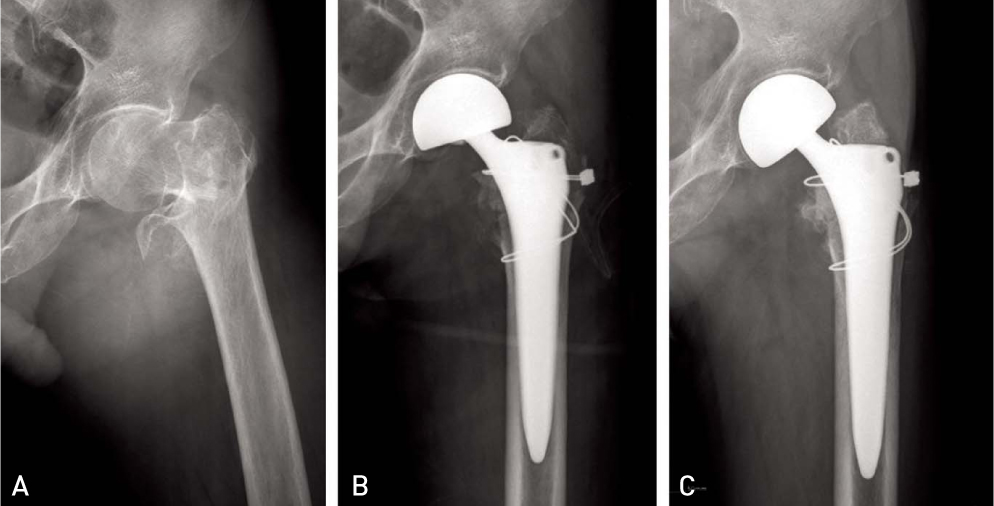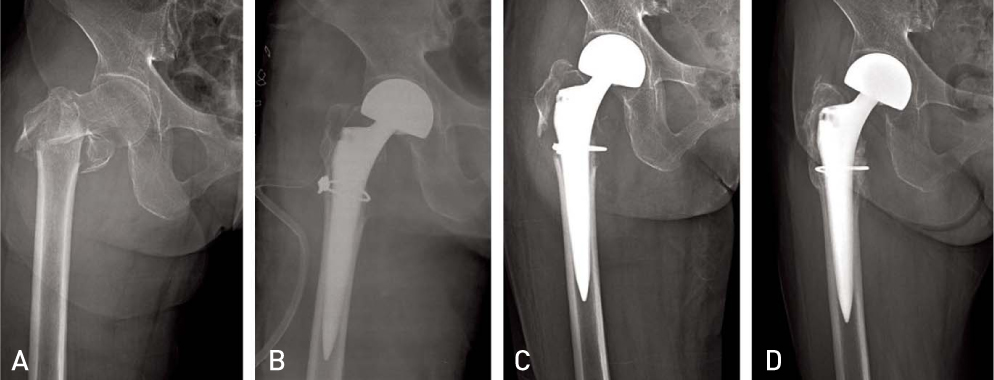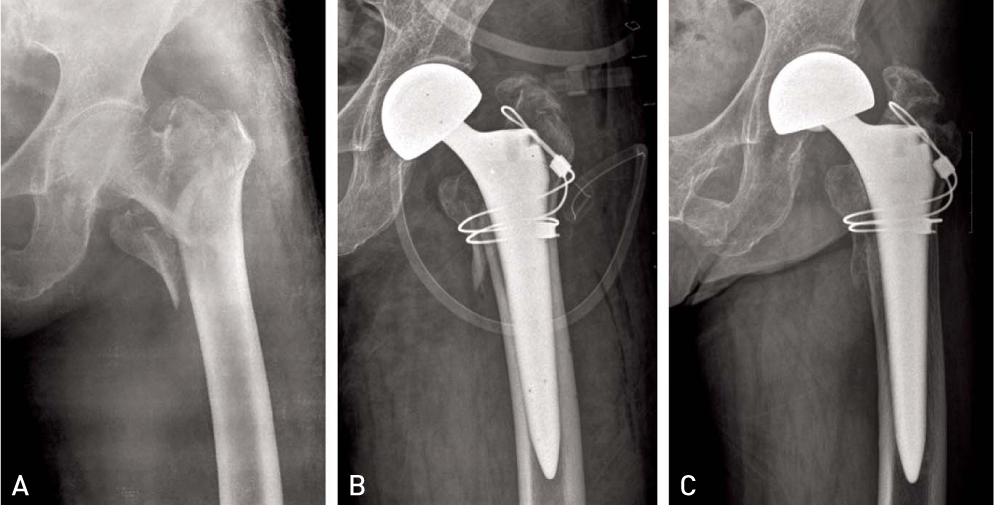Hip Pelvis.
2012 Sep;24(3):222-230. 10.5371/hp.2012.24.3.222.
Cementless Bipolar Hemiarthroplasty Using a Rectangular Cross-section Stem for Type A2 or above Intertrochanteric Fractures
- Affiliations
-
- 1Department of Orthopedic Surgery, Gwangju Veterans Hospital, Gwangju, Korea. chm1228@hanmail.net
- KMID: 2054136
- DOI: http://doi.org/10.5371/hp.2012.24.3.222
Abstract
- PURPOSE
To evaluate the treatment outcome for Type A2 or above intertrochanteric fractures in elderly patients using cementless bipolar hemiarthroplasties incorporating a standard (tapered, rectangular) stem.
MATERIALS AND METHODS
We retrospectively reviewed the records of 37 patients who had undergone bipolar hemiarthroplasty between February 2006 and February 2010 in our hospital, and who had received follow up evaluation for more than two years after the surgery. The mean patient age was 73.5 years (range 65-88 years), and 16 patients were male and 21 were female. We evaluated the the results of their treatment by analyzing the operation duration, volume of bleeding, measured results for the recovery of walking capability, and any complications and radiologic findings.
RESULTS
The mean operation duration was 75.3 minutes(50-185 minutes). The average total volume of bleeding was of 755.5 cc(75-1,400 cc). Upon the final follow-up visit, 27 patients(72.9%) had recovered more than 80% of their pre-injury Barthel index values(72.8+/-15.1). Complications included one case of deep infection, one case of acetabular erosion, and 3 cases of greater trochanter non-union. There were no cases of revisions due to prosthesis loosening or for other reasons.
CONCLUSION
Cementless bipolar hemiarthroplasty using a tapered, rectangular stem is a viable alternative treatment for type A2 intertrochanteric fractures in elderly patients which supports rapid patient mobilization ability.
MeSH Terms
Figure
Reference
-
1. Wiss DA. What's new in orthopaedic trauma. J Bone Joint Surg Am. 2001. 83-A:1762–1772.
Article2. Park MS, Lim YJ, Kim YS, Kim KH, Cho HM. Treatment of the proximal femoral fractures with proximal femoral nail antirotation (PFNA). J Korean Fract Soc. 2009. 22:91–97.
Article3. Babst R, Renner N, Biedermann M, et al. Clinical results using the trochanter stabilizing plate (TSP): the modular extension of the dynamic hip screw (DHS) for internal fixation of selected unstable intertrochanteric fractures. J Orthop Trauma. 1998. 12:392–399.
Article4. Adams CI, Robinson CM, Court-Brown CM, McQueen MM. Prospective randomized controlled trial of an intramedullary nail versus dynamic screw and plate for intertrochanteric fractures of the femur. J Orthop Trauma. 2001. 15:394–400.
Article5. Simmermacher RK, Bosch AM, Van der Werken C. The AO/ASIF-proximal femoral nail (PFN): a new device for the treatment of unstable proximal femoral fractures. Injury. 1999. 30:327–332.
Article6. Stern MB, Angerman A. Comminuted intertrochanteric fractures treated with a Lienbach prosthesis. Clin Orthop Relat Res. 1987. (218):75–80.7. Green S, Moore T, Proano F. Bipolar prosthetic replacement for the management of unstable intertrochanteric hip fractures in elderly. Clin Orthop Relat Res. 1987. (224):169–177.8. Haentjens P, Casteleyn PP, De Boeck H, Handelberg F, Opdecam P. Treatment of unstable intertrochanteric and subtrochanteric fractures in elderly patients. Primary bipolar arthroplasty compared with internal fixation. J Bone Joint Surg Am. 1989. (71):1214–1225.
Article9. Kim BH, Chung YY, Ki SC, Yoon DH, Ryu JH. Cementless bipolar hemiarthroplasty for unstable intertrochanteic fractures in the elderly. J Korean Orthop Assoc. 2011. 46:399–404.
Article10. Lee YK, Ha YC, Chang BK, Kim KC, Kim TY, Koo KH. Cementless bipolar hemiarthroplasty using a hydroxyapatite-coated long stem for osteoporotic unstable intertrochanteric fractures. J Arthroplasty. 2011. 26:626–632.
Article11. Singh M, Nagrath AR, Maini PS. Changes in trabecular pattern of the upper end of the femur as an index of osteoporosis. J Bone Joint Surg Am. 1970. 52:457–467.
Article12. Evans EM. The treatment of trochanteric fractures of the femur. J Bone Joint Surg Br. 1949. 31B:190–203.
Article13. Hardy DC, Descamps PY, Krallis P, et al. Use of an intramedullary hip-screw compared with a compression hip-screw with a plate for intertrochanteric femoral fractures. A prospective, randomized study of one hundred patients. J Bone Joint Surg Am. 1998. 80:618–630.
Article14. Koval KJ, Aharonoff GB, Rosenberg AD, Bernstein RL, Zuckerman JD. Functional outcome after hip fracture. Effect of general versus regional anesthesia. Clin Orthop Relat Res. 1998. (348):37–41.15. Parker MJ, Palmer CR. A new mobility score for predicting mortality after hip fracture. J Bone Joint Surg Br. 1993. 75:797–798.
Article16. D'Aubigne RM, Postel M. Functional results of hip arthroplasty with acrylic prosthesis. J Bone Joint Surg Am. 1954. 36-A:451–475.17. Mahoney FI, Barthel DW. Functional evaluation: the Barthel index. Md State Med J. 1965. 14:61–65.18. Brooker AF, Bowerman JW, Robinson RA, Riley LH Jr. Ectopic ossification following total hip replacement. Incidence and a method of classification. J Bone Joint Surg Am. 1973. 55:1629–1632.19. Gruen TA, McNeice GM, Amstutz HC. "Modes of failure" of cemented stem-type femoral components: a radiographic analysis of loosening. Clin Orthop Relat Res. 1979. (141):17–27.20. Engh CA, Bobyn JD, Glassman AH. Porous-coated hip replacement. The factors governing bone ingrowth, stress shielding, and clinical results. J Bone Joint Surg Br. 1987. 69:45–55.
Article21. Callaghan JJ, Salvati EA, Pellicci PM, Wilson PD Jr, Ranawat CS. Results of revision for mechanical failure after cemented total hip replacement, 1979 to 1982. A two to five-year follow-up. J Bone Joint Surg Am. 1985. 67:1074–1085.
Article22. Jensen JS, Sonne-Holm S. Critical analysis of Ender nailing in the treatment of trochanteric fractures. Acta Orthop Scand. 1980. 51:817–825.
Article23. Kyle RF, Gystilo RB, Premer RF. Analysis of six hundred and twenty-two intertrochanteric hip fractures. J Bone Joint Surg Am. 1979. 61:216–221.
Article24. Wolfgang GL, Bryant HH, O'Neill JP. Treatment of intertrochanteric fracture of the femur using sliding screw plate fixation. Clin Orthop Relat Res. 1982. (163):148–158.
Article25. Christie J, Burnett R, Potts HR, Pell AC. Echocardiography of transatrial embolism during cemented and uncemented hemiarthroplasty of the hip. J Bone Joint Surg Br. 1994. 76:409–412.
Article26. Kayali C, Agus H, Ozluk S, Sanli C. Treatment for unstable intertrochanteric fractures in elderly patients: internal fixation versus cone hemiarthroplasty. J Orthop Surg (Hong Kong). 2006. 14:240–244.
Article27. Delaunay C, Bonnomet F, North J, Jobard D, Cazeau C, Kempf JF. Grit-blasted titanium femoral stem in cementless primary total hip arthroplasty: a 5- to 10-year multicenter study. J Arthroplasty. 2001. 16:47–54.
Article28. Swanson TV. The tapered press fit total hip arthroplasty: a European alternative. J Arthroplasty. 2005. 20:63–67.29. Glassman AH, Crowninshield RD, Schenck R, Herberts P. A low stiffness composite biologically fixed prosthesis. Clin Orthop Relat Res. 2001. (393):128–136.
Article30. Gross TS, Damji AA, Judex S, Bray RC, Zernicke RF. Bone hyperemia precedes disuse-induced intracortical bone resorption. J Appl Physiol. 1999. 86:230–235.
- Full Text Links
- Actions
-
Cited
- CITED
-
- Close
- Share
- Similar articles
-
- Bipolar Hemiarthroplasty with Cementless Femoral Stem for Unstable Intertrochanteric Fractures
- Cementless Bipolar Hemiarthroplasty for Unstable Intertrochanteric Fractures in Elderly Patients
- Comparison between Cementless and Cemented Bipolar Hemiarthroplasty for Treatment of Unstable Intertrochanteric Fractures: Systematic Review and Meta-analysis
- Bipolar Hemiarthroplasty in Unstable Intertrochanteric Fractures with an Effective Wiring Technique
- Treatment of intertrochanteric fractures with bipolar hemiarthroplasty in the elderly





